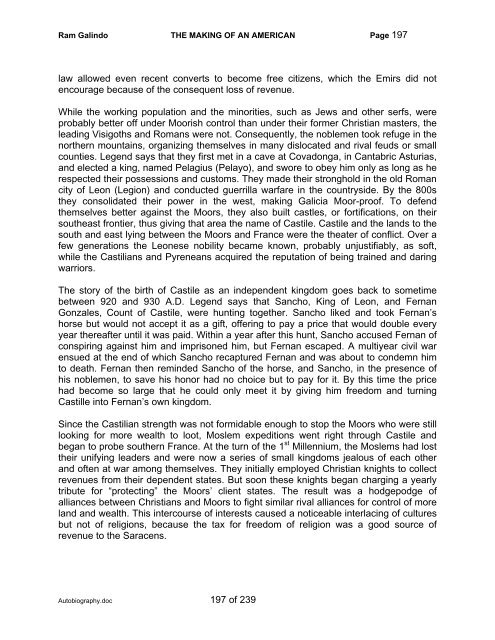Autobiography - The Galindo Group
Autobiography - The Galindo Group
Autobiography - The Galindo Group
You also want an ePaper? Increase the reach of your titles
YUMPU automatically turns print PDFs into web optimized ePapers that Google loves.
Ram <strong>Galindo</strong> THE MAKING OF AN AMERICAN Page 197<br />
law allowed even recent converts to become free citizens, which the Emirs did not<br />
encourage because of the consequent loss of revenue.<br />
While the working population and the minorities, such as Jews and other serfs, were<br />
probably better off under Moorish control than under their former Christian masters, the<br />
leading Visigoths and Romans were not. Consequently, the noblemen took refuge in the<br />
northern mountains, organizing themselves in many dislocated and rival feuds or small<br />
counties. Legend says that they first met in a cave at Covadonga, in Cantabric Asturias,<br />
and elected a king, named Pelagius (Pelayo), and swore to obey him only as long as he<br />
respected their possessions and customs. <strong>The</strong>y made their stronghold in the old Roman<br />
city of Leon (Legion) and conducted guerrilla warfare in the countryside. By the 800s<br />
they consolidated their power in the west, making Galicia Moor-proof. To defend<br />
themselves better against the Moors, they also built castles, or fortifications, on their<br />
southeast frontier, thus giving that area the name of Castile. Castile and the lands to the<br />
south and east lying between the Moors and France were the theater of conflict. Over a<br />
few generations the Leonese nobility became known, probably unjustifiably, as soft,<br />
while the Castilians and Pyreneans acquired the reputation of being trained and daring<br />
warriors.<br />
<strong>The</strong> story of the birth of Castile as an independent kingdom goes back to sometime<br />
between 920 and 930 A.D. Legend says that Sancho, King of Leon, and Fernan<br />
Gonzales, Count of Castile, were hunting together. Sancho liked and took Fernan’s<br />
horse but would not accept it as a gift, offering to pay a price that would double every<br />
year thereafter until it was paid. Within a year after this hunt, Sancho accused Fernan of<br />
conspiring against him and imprisoned him, but Fernan escaped. A multiyear civil war<br />
ensued at the end of which Sancho recaptured Fernan and was about to condemn him<br />
to death. Fernan then reminded Sancho of the horse, and Sancho, in the presence of<br />
his noblemen, to save his honor had no choice but to pay for it. By this time the price<br />
had become so large that he could only meet it by giving him freedom and turning<br />
Castille into Fernan’s own kingdom.<br />
Since the Castilian strength was not formidable enough to stop the Moors who were still<br />
looking for more wealth to loot, Moslem expeditions went right through Castile and<br />
began to probe southern France. At the turn of the 1 st Millennium, the Moslems had lost<br />
their unifying leaders and were now a series of small kingdoms jealous of each other<br />
and often at war among themselves. <strong>The</strong>y initially employed Christian knights to collect<br />
revenues from their dependent states. But soon these knights began charging a yearly<br />
tribute for “protecting” the Moors’ client states. <strong>The</strong> result was a hodgepodge of<br />
alliances between Christians and Moors to fight similar rival alliances for control of more<br />
land and wealth. This intercourse of interests caused a noticeable interlacing of cultures<br />
but not of religions, because the tax for freedom of religion was a good source of<br />
revenue to the Saracens.<br />
<strong>Autobiography</strong>.doc 197 of 239


